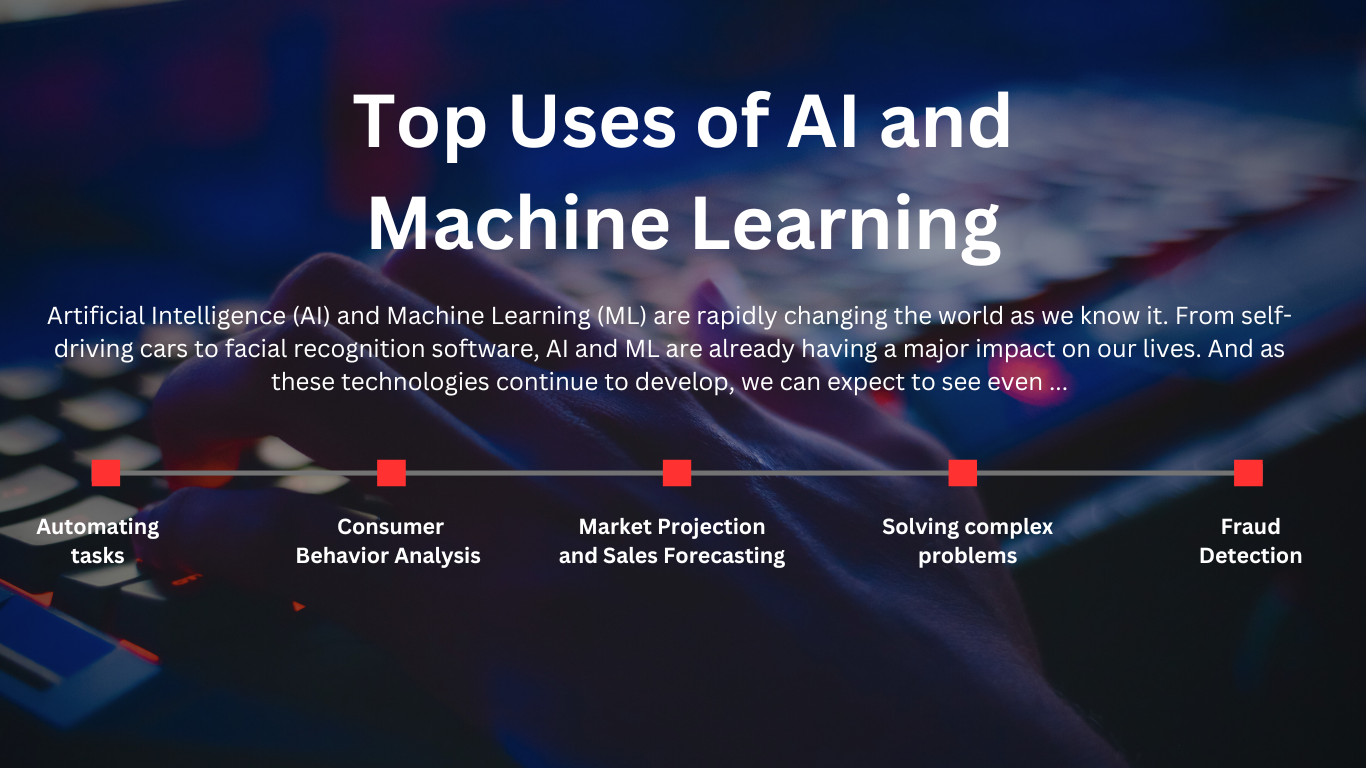
Trends in market research are in constant flux, driven by technological advancements, shifts in consumer behavior, and global economic changes. According to a report by The Business Research Company, the global market research services market expanded from USD 84.33 billion in 2023 to USD 87.68 billion in 2024, with a compound annual growth rate (CAGR) of 4.0%. Projections indicate further growth to USD 95.49 billion by 2027, at a CAGR of 3.3%.
A study by Qualtrics revealed that 62% of researchers surveyed noted significant reliance on research and insights within their respective companies, with a substantial portion of research budgets allocated to key areas.
Here, we explore the significant trends in market research shaping the 2024 landscape, providing valuable insights and opportunities for businesses to maintain competitiveness.
Latest Trends in Market Research for 2024
Trend 1: AI and ML in Market Research
Artificial Intelligence (AI) and Machine Learning (ML) are controlled to revolutionize market research practices by enhancing efficiency across various processes, from data collection to predictive modeling. These technologies will automate tasks, allowing researchers to focus on strategic interpretation. AI-driven sentiment analysis will be pivotal in understanding consumer emotions and opinions, facilitating refined brand strategies tailored to consumer sentiment while addressing ethical considerations and user privacy.

The Future of AI and Machine Learning
AI and ML are still in their early stages of development, but they have the potential to revolutionize the world as we know it. In the years to come, we can expect to see even more innovative and groundbreaking applications for these technologies.
AI and ML applications in market research bring numerous advantages, including:
- Advanced pattern recognition
- Predictive analytics for market trends
- and automated sentiment analysis
Trend 2: Emphasis on Big Data Analytics
The era of big data has elevated the significance of predictive analytics in market research. Businesses will increasingly rely on advanced analytics techniques to identify patterns, forecast trends, and gain deeper insights into their target audience. This approach enables data-driven decision-making, optimizing marketing strategies, and creating personalized customer experiences.
Big data analytics has transformed market research by providing deeper insights through:
- Comprehensive consumer behavior analysis
- Real-time market trend tracking
- Data-driven strategic planning
Trend 3: Adoption of Video for Qualitative Research
Video-based research methodologies are gaining traction, offering richer insights compared to traditional text-based approaches. The surge in online/video focus groups and consumer-generated video content presents an opportunity for businesses to capture nuanced data such as body language and facial expressions. Leveraging video analytics platforms allows for efficient processing of large volumes of data, providing valuable insights across various industries.
The rise of voice search and virtual assistants has significantly influenced consumer behavior by:
- Expanding ways for people to search
- Creating new marketing channels
- Personalizing user experiences
Trend 4: Leveraging Social Listening and Sentiment Analysis
Social media platforms serve as helpful sources of real-time consumer insights. By employing social listening and sentiment analysis tools, businesses can monitor customer sentiment, identify emerging trends, and engage with their audience effectively. Harnessing data from social media enables organizations to understand public perception, track competitor activities, and inform decision-making processes.
Social listening and sentiment analysis provide invaluable insights into consumer sentiments by:
- Tracking brand engagement and reputation
- Analyzing customer feedback on social media and other platforms
- Identifying emerging trends in market research based on interactions
Trend 5: Mobile Research and Location-Based Targeting
The ubiquity of smartphones has propelled the adoption of mobile market research methodologies. Surveys, in-app feedback, and location-based research enable businesses to gather real-time insights from consumers on the move. The accessibility of mobile market research facilitates a comprehensive understanding of consumer behavior, enabling organizations to adapt strategies accordingly.
Mobile research and location-based targeting have a profound impact on marketing strategies by:
- Enabling hyper-localised marketing
- Offering real-time consumer data
- Tailoring campaigns based on location-specific trends in market research
Trend 6: AR and VR in Market Research
Virtual Reality (VR) and Augmented Reality (AR) technologies are expanding beyond gaming, offering immersive experiences for market research. By simulating real-life scenarios, businesses can gauge emotional responses, test product prototypes, and enhance customer experiences, providing valuable data to drive innovation and satisfaction.
Augmented Reality (AR) and Virtual Reality (VR) are shaping the future of immersive technologies in market research by:
- Creating realistic product simulations
- Facilitating immersive focus group experiences
- Enhancing consumer engagement through interactive platforms
Trend 7: Blockchain for Data Security
Blockchain technology ensures transparency, integrity, and security in data transactions, addressing concerns about data accuracy and participant anonymity. Its adoption in market research enhances security and trust among participants, leading to more reliable results and fostering a conducive research environment.
Blockchain technology ensures transparency and security in market research by:
- Providing tamper-proof data storage
- Enhancing participant privacy
- Facilitating secure data sharing
Trend 8: Predictive Analytics and Forecasting
Predictive analytics empower businesses to make proactive decisions based on anticipated trends in market research, identifying potential disruptions and opportunities. This approach enables organizations to stay ahead of the competition and optimize strategies, particularly beneficial in sectors with rapidly changing dynamics.
Predictive analytics and forecasting are crucial in predicting market trends by:
- Utilizing historical data for modeling outcomes
- Identifying potential market shifts
- Aiding in proactive strategy development
Trend 9: Collaborative Research with Consumers
Ethnographic research gains importance, providing rich qualitative data by observing consumer behavior in natural environments. Immersion in consumers’ worlds facilitates a deeper understanding, uncovering unmet needs and informing product and service development.
Collaborative research with consumers benefits market research by:
- Increasing the accuracy of data concerning user needs
- Gaining direct consumer insights
- Enhancing product development through real-time feedback
Trend 10: Personalisation in Research Findings
Tailoring research findings to individual preferences enhances engagement and relevance, driving actionable insights and fostering stronger connections with the target audience.
Personalization in research findings caters to specific business needs by:
- Setting unique business objectives as parameters for analysis
- Offering niche market insights
- Enhancing the relevance of research outcomes for multiple business aspects
Trend 11: Integrated Research Approaches
Integrated research approaches combine various methodologies to provide a more holistic view of the market. This trend involves merging qualitative and quantitative data, online and offline research, and various technological tools.
Integrated research approaches combine various methods for:
- Comprehensive market analysis
- Cross-validation of research findings
- Leveraging the strengths of different methodologies
Trend 12: Emotion and Neuromarketing Research
Analyzing facial expressions and emotional responses provides deeper insights into consumer behavior, enabling businesses to create emotionally engaging marketing campaigns and enhance customer experiences.
Emotion and neuromarketing research contribute to understanding consumer psychology by:
- Collecting and analyzing emotional responses to marketing stimuli
- Mapping consumer preferences according to response
- Enhancing the mental and emotional appeal of products
Trend 13: Cross-Cultural Research
Understanding cultural influences on consumer behavior is crucial for global businesses, necessitating cross-cultural research approaches to ensure the relevance and effectiveness of strategies across diverse markets.
Cross-cultural research is key to expanding into global markets by:
- Understanding consumer behavior across regions
- Tailoring products to specific preferences
- Identifying trends and opportunities for localization
Conclusion
Looking ahead to 2024 and beyond, it’s clear that AI, data analytics, user experience, and research will all play significant roles in understanding the market. As industries continue to evolve, the field of market research in 2024 offers numerous opportunities for businesses to utilize advanced technologies, data analytics, and consumer insights to drive growth and innovation. Embracing these trends in market research allows organizations to stay ahead of the curve and effectively meet evolving customer needs. To learn more about our services, please get in touch with us at user.com.sg/contact-user.



